
Features of the Bandera Crater flow,
Including Aa Lava & Ice Caves
The following images were taken as part of the 2000 Rockin' around New Mexico meeting, held in Grants, New Mexico. The captions and locations were prepared by participants on the field trip. For an enlarged version of any image, click on the small version of the image.
A number of interesting features are associated with the 10,000 year old Bandera Crater eruption. In addition to the cinder cone, discussed on a different page, the Bandera Crater eruption produced aa lava, collapse pits, spines, spatter cones, and lava tubes, one of which contains perennial ice. In contrast to pahoehoe lava, aa has a very loose and rubbly surface. Aa flows form from lava that is more viscous than pahoehoe.
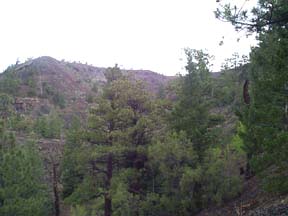 |
GPS LOCATION: N34° 59.760' W108° 5.141' |
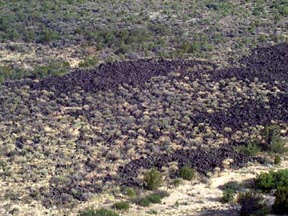 |
Photo taken from Sandstone Overlook CAPTION: This photo shows the difference between aa and pahoehoe lava flows. The aa areas are the rubbly-looking areas on the photo, whereas pahoehoe of the same age is smoother and more vegetated. The surface of the aa is loose and rubbly. This photo is not of the Bandera flow, but rather of the less-vegetated McCartys flow. |
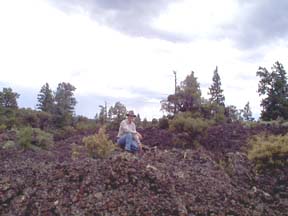 |
GPS LOCATION: N34° 57.569' W108° 04.850' CAPTION: This lava field is made up of aa lava. Aa lava is composed of jagged, broken lava produced when the surface of the flow cools and hardens while underlying lava is still in motion. There are a variety of trees and shrubs covering the field that include salt cedar, juniper, ponderosa pine and sage. |
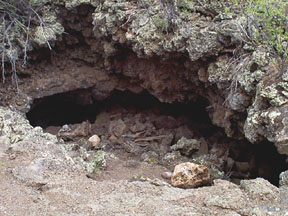 |
GPS LOCATION: N34° 59.556' W108° 04.926' CAPTION: This is the site of a collapsed lava tube, referred to locally as "the natural ice box." The temperature inside is approximately 50°F, significantly cooler than the summertime above-ground ambient temperature. The well-insulated pit approximates the mean annual temperature. Locals once stored food here to keep it from spoiling. The temperature inside is relative constant, year-round. |
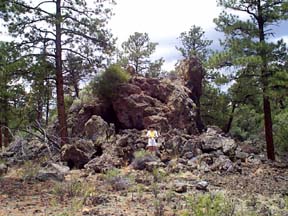 |
GPS LOCATION: N34° 59.556' W108° 04.926' CAPTION: Volcanic spine probably caused by slowly flowing, viscous aa lava. When the front stopped, the flow behind back up against it, building up pressure and pushing up the spine. This feature is not a vent, but simply a part of the aa flow. This type of spine is not likely to be observed in less viscous pahoehoe lava, but a "squeeze-up" is a similar, but much smaller feature that form by a similar mechanism in pahoehoe. |
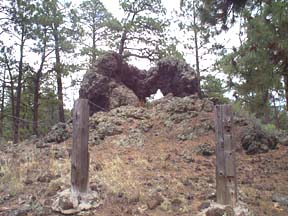 |
GPS LOCATION: N34° 59' 41" W108°
04' 55.3" CAPTION: This photo shows a spatter cone, which is a feature seen on some basaltic lava flows. This is not an actual vent, but is a feature that may have formed when the lava flow moved across a damp or wet earth, generating steam which exploded up through the flow. Another possible mechanism by which this feature could have formed is by overpressured magma escaping through a fissure in the cooled top of a lava flow. |
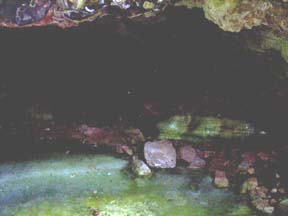 |
GPS LOCATION: N34° 59.491' W108° 04.928 |
 |
GPS LOCATION: N36° 59.157' W108° 04.934' CAPTION: Lava flows have been used by past civilizations. Here, is a circular stack of lava forming an Anasazi ruins. Lava has excellent insulating properties and therefore was good to use in shelters, especially those shelters used in areas of rapid temperature changes. |
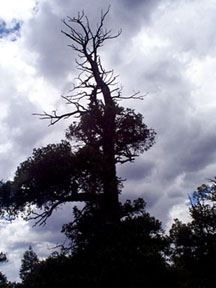 |
GPS LOCATION: N34° 59.553' W108° 04.901' CAPTION: Gnarled and twisted the 700 year-old Douglas Fir survives adversity. Its shallow roots reach into the sparse soil in the Bandera aa lava. The carrot-like shape of the tree typifies trees under stress. The Douglas Fir stands 4 to 5 meters high in contrast to an average Fir, which could top out at 50-80 meters at maturity (100 to 150 years). |


